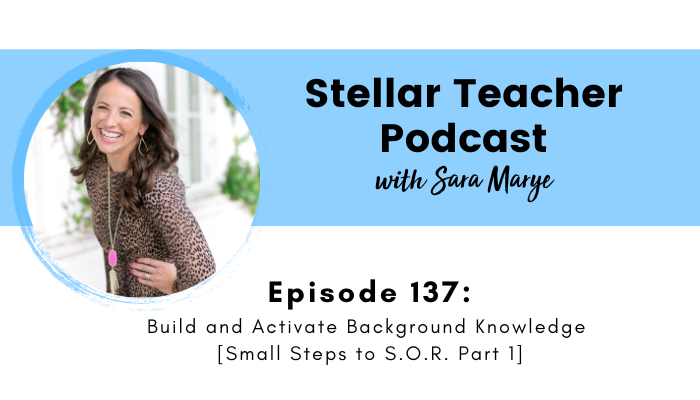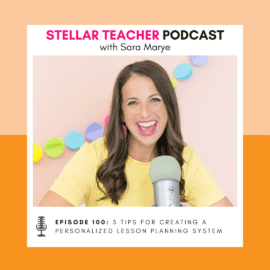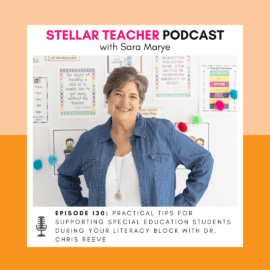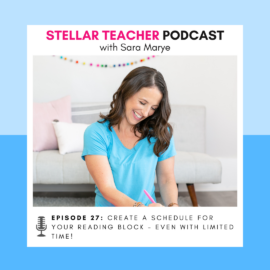
Click play below to hear how to build and activate background knowledge:
I’m excited to start my summer bonus episodes that happen every Thursday where I’m sharing one small step you can take to align your instruction to the science of reading. My goal is to help you feel confident in your instruction and have the tools and knowledge to provide effective lessons for your students. The first step towards the science of reading I’m sharing is how to build and activate background knowledge.
To better understand why background knowledge is such an important aspect to aligning your instruction to the science of reading, you first need an understanding of Scarborough’s reading rope. With that knowledge, I provide practical application and a simple framework to help students build and activate background knowledge. The first of many small, actionable steps will help you apply this to your instruction when school resumes in the fall.
In this episode on ways to build and activate background knowledge, I share:
- A small, actionable step that aligns your instruction to the science of reading
- A comparison of background knowledge to mental Velcro
- Difference between background knowledge and prior knowledge
- A simple framework for thinking about background knowledge
Resources:
- Marilyn Jager Adams “Knowledge For Literacy” Article
- Sign up for my Private Podcast: Confident Writer Systems Series
- Check out the Stellar Literacy Collective Membership
- If you’re enjoying this podcast, please leave a review on Apple Podcasts!
Related episodes and blog posts:
- Episode 136, What Does the Science of Reading Look Like in Upper Elementary?
- Episode 88, Science of Reading Q&A
- Episode 87, Breaking Down the Elements of Language Comprehension (and Practical Implementation Ideas!)
- Episode 85, What is the Science of Reading & Why is it Important?
Connect with me:
- Join my newsletter
- Shop my TPT store here
- Instagram: @thestellarteachercompany
More About Stellar Teacher Podcast:
Welcome to the Stellar Teacher Podcast! We believe teaching literacy is a skill. It takes a lot of time, practice, and effort to be good at it. This podcast will show you how to level up your literacy instruction and make a massive impact with your students, all while having a little fun!
Your host, Sara Marye, is a literacy specialist passionate about helping elementary teachers around the world pass on their love of reading to their students. She has over a decade of experience working as a classroom teacher and school administrator. Sara has made it her mission to create high quality no-fluff resources and lesson ideas that are both meaningful and engaging for young readers.
Each week, Sara and her guests will share their knowledge, tips, and tricks so that you can feel confident in your ability to transform your students into life-long readers.
Tune in on your favorite podcast platform: Apple, Google, Amazon, Spotify, Stitcher, and more! If you’re loving this podcast, please rate, review, and follow!
Podcast (stellar-teacher-podcast): Play in new window | Download
Hey, teachers, and welcome to our small steps to SOR Summer Series. For the next seven weeks, I’m going to be doing a bonus episode of the podcast every Thursday, where I’m going to share one small step that you can take to align your instruction to the science of reading.
And I have gotten so many questions from teachers about what does the science of reading look like in upper elementary? And I know that so many schools are adopting new reading programs, or they are shifting their curriculum focus, or they’re sending their teachers to PD to learn more about the science of reading, which I think is great.
I know that personally, I have learned so much over the past few years through my own personal research. And while I’m definitely not an expert, I have really loved being on this journey with you of becoming a more informed and effective educator. And I love using this podcast to share what I am learning about the science of reading with you.
But I also know that anytime there is a shift, or a change in the way that we teach something, it can feel really overwhelming. And honestly, it can be a little bit scary for teachers. Starting something new can be really uncomfortable. But it can also be really exciting because it’s an opportunity for us to learn something new and really, I don’t know redefine how we teach literacy.
So if your school is telling you that we need to change the way that we’ve been teaching, and that we’re going to shift to the science of reading, even if it feels overwhelming, it can be really exciting. And I want you to be excited about it. I want you to feel confident in your instruction. And I want you to feel like you have the tools and the knowledge to be able to provide effective lessons to your students.
And I’m assuming you want something similar because that’s probably one of the reasons why you tune into the podcast each week. So my goal with this series is to give you small, actionable steps that you can apply to your instruction when school resumes in the fall.
And hopefully by taking these small steps, not only will you feel much more confident in aligning your instruction to the science of reading, but you’ll also be delivering more effective lessons which will lead to your students achieving more growth in reading. So let’s jump in and get this series started.
So your first small step is to build and activate background knowledge anytime you are reading aloud. And let me explain how this aligns to the science of reading. So one of the models that does a really great job of explaining what the science of reading is, is Scarborough’s reading rope.
And if we look at Scarborough’s reading rope, we know that there are two strands that need to be woven together to help our students become skilled readers: word recognition, and language comprehension. And word recognition refers to our student’s ability to actually read and decode the words in the text. And language comprehension refers to a student’s ability to understand and make meaning of the words and the texts that they read or hear.
So both word recognition and language comprehension are necessary if we want our students to become skilled readers. Well, one of the elements in the language comprehension strand is background knowledge. And the end goal of reading is always to help our students comprehend and understand what it is that they read. And having knowledge of the topic that they are reading about plays a key role in that.
There is this really great quote from Marilyn Jager Adams article knowledge for literacy, which I’ll link to in the show notes in case you want to check it out. But in that article, she says, “Prior knowledge about a topic is like mental Velcro. The relevant knowledge gives the words of the text places to stick and make sense, thereby supporting comprehension and propelling the reading process forward.”
And I just love that visual of prior knowledge being like mental Velcro and helping information stick in our brains better. So we want to make sure that we are activating and building background knowledge when we read to help give students that mental Velcro.
So first of all, let’s define background knowledge and prior knowledge because they’re slightly different. So teachers often use these terms interchangeably, and both of them are important, but prior knowledge refers to the facts, concepts and the understanding that a student has on a topic. It’s really what it is that the student brings to the reading experience, and we have no control over the prior knowledge that our students have.
Background knowledge is text dependent. And it refers to the specific vocabulary terms, the facts, the concepts and the information that a student really must have in order to understand the events, the problems or the ideas presented in the text. So background knowledge is really what do our students need to know before reading in order to best understand the text.
And in some cases, students might actually have enough prior knowledge that their background knowledge is sufficient for them to understand the text. But in other cases, they might not have enough prior knowledge and you are going to have to build up their background knowledge on a topic before the reading can begin.
So that’s why I think it’s always a good idea to be intentional about building background knowledge before you begin reading. So that way, you can try to get all your students on a level playing field in terms of having enough background knowledge to understand the text.
So let’s talk a little bit about how do we actually build background knowledge. So Nancy Hennessy wrote the Comprehension Blueprint, which is one of my favorite books that I’ve used to understand the science of reading. And in her book, she provides a really great framework for how you can think about background knowledge.
And she calls it the ABCs of background knowledge. First, you can activate and assess background knowledge, then we want to build background knowledge, and then finally, we want to connect to existing background knowledge. And this is a really easy framework that you can use, anytime you read with your students just think ABCs.
So let’s talk practical application of what this looks like. So the first step in building background knowledge is to activate and assess the knowledge that your students might already have. This is where you want to see what prior knowledge do they already have about the topic.
And you could do this in a few ways. You could use a KWL chart, and you could find out what your students already know about a topic and find out what they want to know about a topic. You could also provide your students with a statement from the text on the topic and ask if they agree or disagree and explain why.
You can even ask them questions to a topic. What do you think would be like to live in blank during blank? How would you feel if you were fill in the blank? Do you remember when we learned about and connected to another topic? So KWL chart, giving them a statement that they either need to agree or disagree and explain why and then asking questions are super simple and quick ways that you can activate and assess your students knowledge before starting to read.
But then we also want to be intentional about actually building background knowledge and making sure that our students have enough knowledge to understand the text that they’re going to read. So this is something that you can do before reading, but you can continue to build their background knowledge during and after reading as well.
And this is where you’re going to teach or expose your students to specific vocabulary terms, facts, concepts, information, anything that a student might need to have in order to better understand the events or problems or ideas presented in the text.
So this step could be explicitly teaching vocabulary terms. Maybe you do a word cloud or a semantic map that helps students understand the connection or the relationship between key words in a text. Maybe you show your students pictures, or images, or maps or an artifact, or something that is going to support an idea or a concept in the text.
It could also be stopping at a teachable moment in the text to make sure students understand the concepts and ideas that you are reading about. And this step doesn’t need to take long. And you don’t have to do all of the things that I mentioned. But you do want to think about what you could do or show your students to give them more information about the topic that will help them with that mental Velcro that I talked about at the beginning of the episode.
And then the final step in the ABCs of background knowledge is to connect to existing knowledge that your students have. And this step is a great way to bring the ABCs full circle. So while we want students to continuously connect to what they are reading to their prior knowledge that they have, we can also be really intentional about prompting them to reflect and make connections to what they are reading.
We kind of need to teach them that we want to constantly be connecting back to our existing knowledge. So this could look like revisiting the KWL chart at the end of your reading and filling in the what I learned section of it. It could be giving your students a sentence stem. I used to think about the topic. But now I think at the end of the lesson and giving them a chance to reflect and connect to what they know.
It could also be reading multiple texts on the same topic and each time you read a text, you have an opportunity to add to their knowledge and connect to what it is that they are learning about, which just enhances the understanding of their topic. And I think one of the really cool things about building background knowledge is that it is empowering and engaging for our students, because we’re giving them a lot more purpose and meaning to our reading experiences.
And inside the Stellar Literacy Collective, which is our membership site for upper elementary teachers, we are constantly trying to provide teachers with resources that really make it easy for teachers to transition to the science of reading and put a lot of these things in practice.
And towards the end of the school year, one of our members Laura shared inside our Facebook community that she was using one of our nonfiction science texts sets on biomes, with her students to do a little extra review at the end of the year. And each of our science texts that includes six texts all on the same topic, but with a different focus.
And so it’s a really great way to build background knowledge because students are reading about a topic, but each article is slightly different. And so the biome set includes six different nonfiction articles, that all have a different focus, but they all connect back to the seven biomes of the world.
And Laura shared that they had been doing one of these science content units on biomes as a shared reading experience, and she said, “My kids are super engaged. Several kids have begun a passion project inspired by what they are reading. And it has been a great way to see them transferring what they have learned about text structures, text features and authors claim.”
And I loved reading this little bit of feedback because we want students to understand key reading skills, like text structure, text features, and author’s claims. But we also want students to develop core content knowledge, like science and social studies and about the biomes. And ultimately, we want students to be engaged and inspired to continue learning on their own, which is what her students were doing.
And one way that we can do all three of those things is to be intentional about building background knowledge with your reading experiences. And when you do that, you are also taking one small step to align your instruction to the science of reading.
So that’s your small step for the week. I hope you tune in next Monday for our regular episode. And be sure to come back next Thursday for our second small step to SOR.








Leave a Comment
You must be logged in to post a comment.